engine MITSUBISHI OUTLANDER 2020 (in English) User Guide
[x] Cancel search | Manufacturer: MITSUBISHI, Model Year: 2020, Model line: OUTLANDER, Model: MITSUBISHI OUTLANDER 2020Pages: 443, PDF Size: 60.03 MB
Page 23 of 443
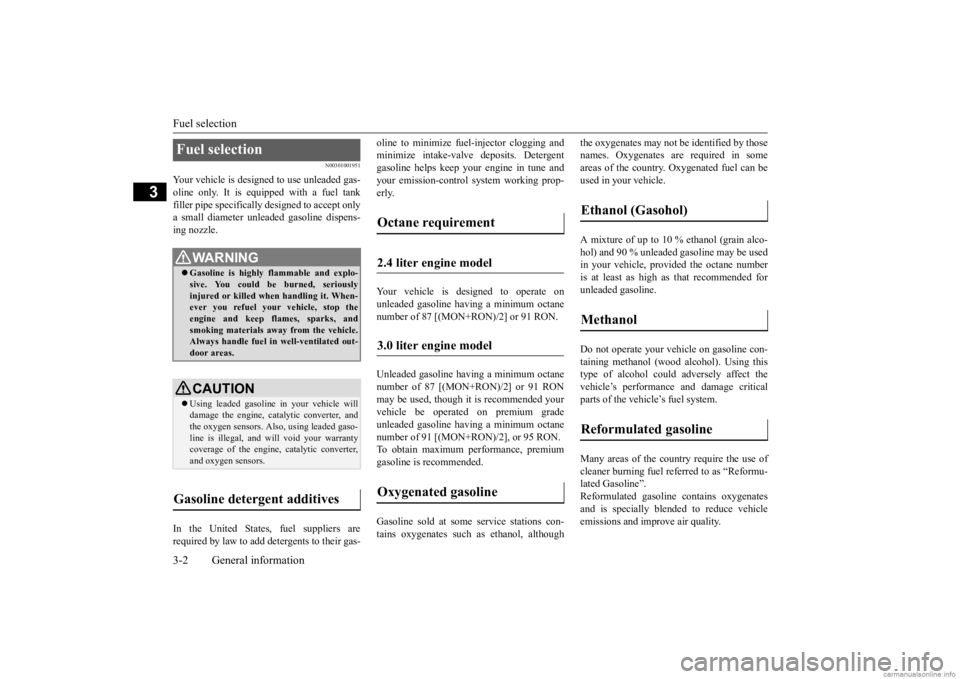
Fuel selection 3-2 General information
3
N00301001951
Your vehicle is designe
d to use unleaded gas-
oline only. It is equipped with a fuel tank filler pipe specifically
designed to accept only
a small diameter unlea
ded gasoline dispens-
ing nozzle. In the United States, fuel suppliers are required by law to add detergents to their gas-
oline to minimize fuel-injector clogging and minimize intake-valve
deposits. Detergent
gasoline helps keep your engine in tune and your emission-control system working prop- erly. Your vehicle is de
signed to operate on
unleaded gasoline having a minimum octane number of 87 [(MON+RON)/2] or 91 RON. Unleaded gasoline having a minimum octane number of 87 [(MON+RON)/2] or 91 RON may be used, though it is recommended yourvehicle be operated on premium grade unleaded gasoline having a minimum octane number of 91 [(MON+RON)/2], or 95 RON. To obtain maximum performance, premium gasoline is recommended. Gasoline sold at some
service stations con-
tains oxygenates such as ethanol, although
the oxygenates may not be identified by those names. Oxygenates are required in someareas of the country. Oxygenated fuel can be used in your vehicle. A mixture of up to 10 % ethanol (grain alco- hol) and 90 % unleaded gasoline may be used in your vehicle, provided the octane number is at least as high as
that recommended for
unleaded gasoline. Do not operate your vehicle on gasoline con- taining methanol (wood alcohol). Using thistype of alcohol could adversely affect the vehicle’s performance
and damage critical
parts of the vehicl
e’s fuel system.
Many areas of the country require the use of cleaner burning fuel referred to as “Reformu-lated Gasoline”. Reformulated gasoline
contains oxygenates
and is specially ble
nded to reduce vehicle
emissions and improve air quality.
Fuel selection
WA R N I N G Gasoline is highly flammable and explo- sive. You could be burned, seriously injured or killed when handling it. When-ever you refuel your
vehicle, stop the
engine and keep fl
ames, sparks, and
smoking materials away from the vehicle.Always handle fuel in well-ventilated out- door areas.CAUTION Using leaded gasoline
in your vehicle will
damage the engine, ca
talytic converter, and
the oxygen sensors. Also, using leaded gaso- line is illegal, and
will void your warranty
coverage of the engine
, catalytic converter,
and oxygen sensors.
Gasoline detergent additives
Octane requirement 2.4 liter engine model 3.0 liter engine model Oxygenated gasoline
Ethanol (Gasohol) Methanol Reformulated gasoline
BK0278200US.book 2 ページ 2019年4月10日 水曜日 午前10時59分
Page 24 of 443
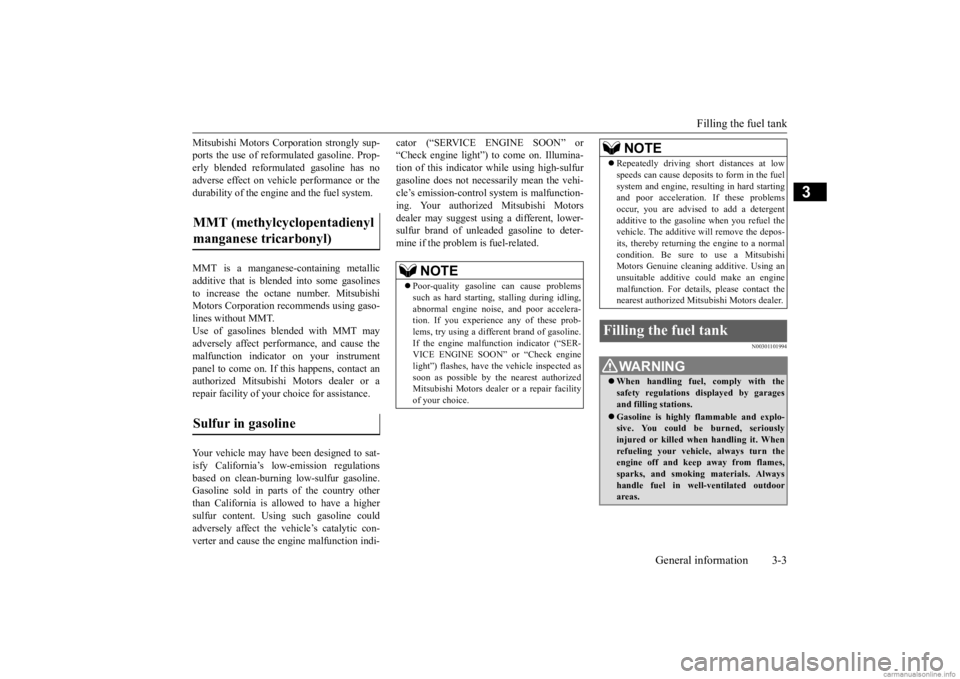
Filling the fuel tank
General information 3-3
3
Mitsubishi Motors Corporation strongly sup- ports the use of reform
ulated gasoline. Prop-
erly blended reformul
ated gasoline has no
adverse effect on vehicle performance or the durability of the engine and the fuel system. MMT is a manganese-containing metallic additive that is blende
d into some gasolines
to increase the octa
ne number. Mitsubishi
Motors Corporation recommends using gaso- lines without MMT. Use of gasolines blended with MMT mayadversely affect performance, and cause the malfunction indicator on your instrument panel to come on. If this happens, contact anauthorized Mitsubishi Motors dealer or a repair facility of your
choice for assistance.
Your vehicle may have
been designed to sat-
isfy California’s low-emission regulations based on clean-burning low-sulfur gasoline.Gasoline sold in parts of the country other than California is allowed to have a higher sulfur content. Using such gasoline couldadversely affect the ve
hicle’s catalytic con-
verter and cause the e
ngine malfunction indi-
cator (“SERVICE ENGINE SOON” or “Check engine light”)
to come on. Illumina-
tion of this indicator
while using high-sulfur
gasoline does not necessa
rily mean the vehi-
cle’s emission-control
system is malfunction-
ing. Your authorized Mitsubishi Motors dealer may suggest using a different, lower- sulfur brand of unleaded gasoline to deter-mine if the problem is fuel-related.
N00301101994
MMT (methylcyclopentadienyl manganese tricarbonyl) Sulfur in gasoline
NOTE
Poor-quality gasoline
can cause problems
such as hard starting, stalling during idling,abnormal engine noise
, and poor accelera-
tion. If you experience any of these prob- lems, try using a differ
ent brand of gasoline.
If the engine malfunc
tion indicator (“SER-
VICE ENGINE SOON”
or “Check engine
light”) flashes, have
the vehicle inspected as
soon as possible by the nearest authorized Mitsubishi Motors dealer
or a repair facility
of your choice.
Repeatedly driving s
hort distances at low
speeds can cause deposits to form in the fuelsystem and engine, resu
lting in hard starting
and poor acceleration.
If these problems
occur, you are advised to add a detergent additive to the gasoline when you refuel thevehicle. The additive
will remove the depos-
its, thereby returning the engine to a normal condition. Be sure
to use a Mitsubishi
Motors Genuine cleani
ng additive. Using an
unsuitable additive could make an engine malfunction. For details,
please contact the
nearest authorized Mitsubishi Motors dealer.
Filling the fuel tank
WA R N I N G When handling fuel, comply with the safety regulations displayed by garagesand filling stations. Gasoline is highly flammable and explo- sive. You could be burned, seriously injured or killed when handling it. When refueling your vehicle,
always turn the
engine off and keep
away from flames,
sparks, and smoking materials. Always handle fuel in well-ventilated outdoor areas.NOTE
BK0278200US.book 3 ページ 2019年4月10日 水曜日 午前10時59分
Page 25 of 443
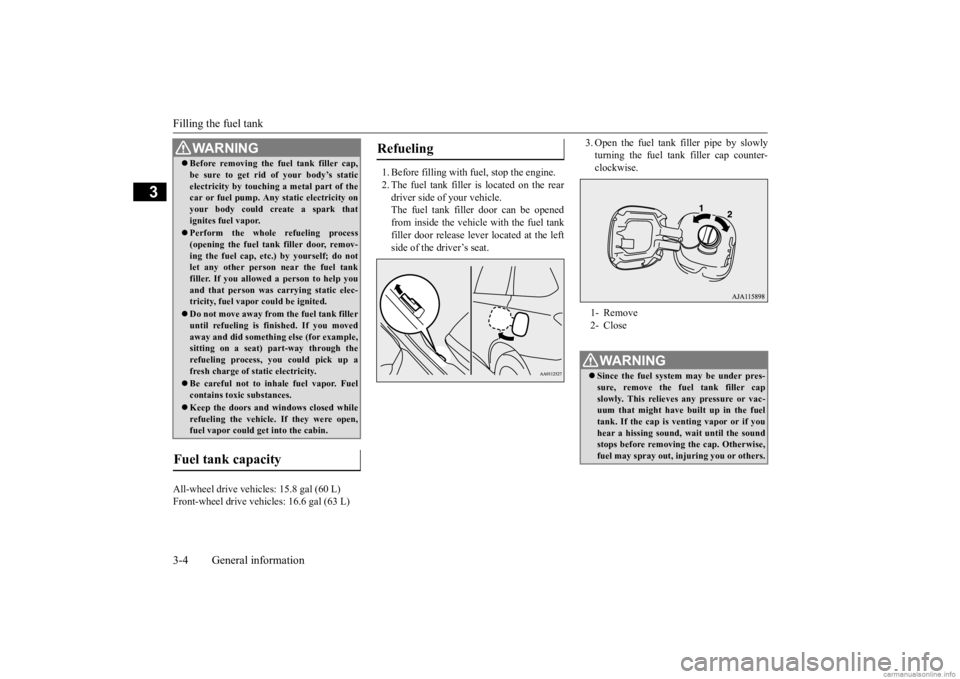
Filling the fuel tank 3-4 General information
3
All-wheel drive vehicles: 15.8 gal (60 L) Front-wheel drive vehi
cles: 16.6 gal (63 L)
1. Before filling with fuel, stop the engine. 2. The fuel tank filler is located on the rear driver side of your vehicle. The fuel tank filler door can be openedfrom inside the vehicle with the fuel tank filler door release lever located at the left side of the driver’s seat.
3. Open the fuel tank filler pipe by slowly turning the fuel tank filler cap counter-clockwise.
Before removing the fuel tank filler cap, be sure to get rid of your body’s staticelectricity by touching a metal part of thecar or fuel pump. Any
static electricity on
your body could create a spark that ignites fuel vapor. Perform the whole
refueling process
(opening the fuel tank filler door, remov-ing the fuel cap, etc.) by yourself; do not let any other
person near the fuel tank
filler. If you allowed
a person to help you
and that person was ca
rrying static elec-
tricity, fuel vapor could be ignited. Do not move away from
the fuel tank filler
until refueling is fi
nished. If you moved
away and did somethin
g else (for example,
sitting on a seat) part-way through the refueling process, you could pick up a fresh charge of st
atic electricity.
Be careful not to inhale fuel vapor. Fuel contains toxic substances. Keep the doors and wi
ndows closed while
refueling the vehicle. If they were open,fuel vapor could ge
t into the cabin.
Fuel tank capacity
WA R N I N G
Refueling
1- Remove 2- CloseWA R N I N G Since the fuel system may be under pres- sure, remove the fuel tank filler capslowly. This relieves
any pressure or vac-
uum that might have built up in the fuel tank. If the cap is venting vapor or if youhear a hissing sound, wait until the sound stops before removing the cap. Otherwise, fuel may spray out, in
juring you or others.
BK0278200US.book 4 ページ 2019年4月10日 水曜日 午前10時59分
Page 26 of 443
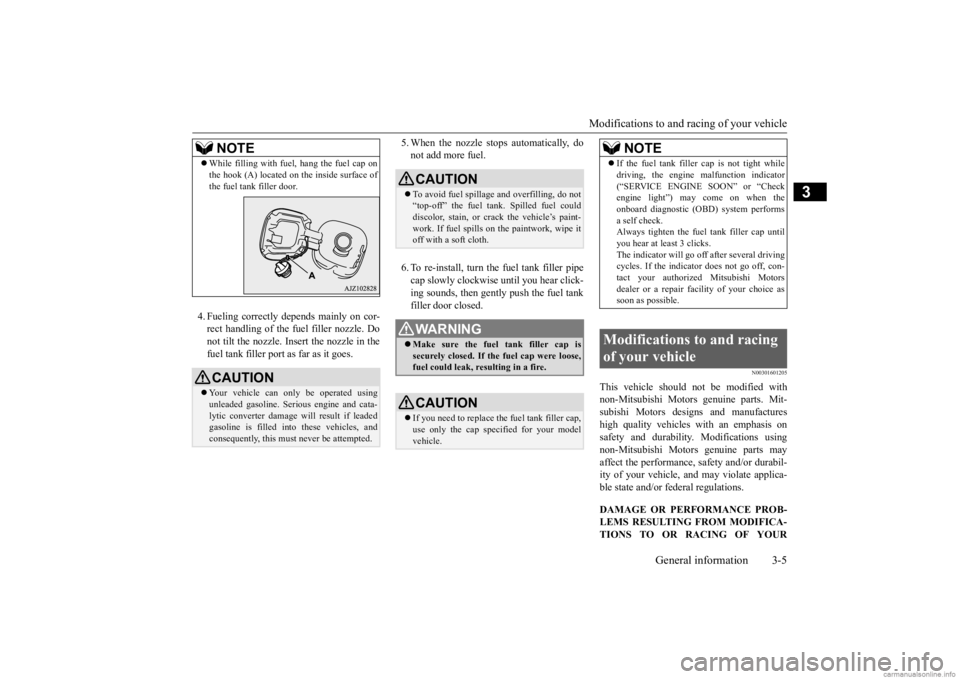
Modifications to and racing of your vehicle
General information 3-5
3
4. Fueling correctly depends mainly on cor- rect handling of the fuel filler nozzle. Donot tilt the nozzle. Insert the nozzle in the fuel tank filler port as far as it goes.
5. When the nozzle stops automatically, do not add more fuel. 6. To re-install, turn the fuel tank filler pipe cap slowly clockwise until you hear click- ing sounds, then gently push the fuel tankfiller door closed.
N00301601205
This vehicle should not be modified withnon-Mitsubishi Motors
genuine parts. Mit-
subishi Motors desi
gns and manufactures
high quality vehicles
with an emphasis on
safety and durability.
Modifications using
non-Mitsubishi Motors genuine parts may affect the performance,
safety and/or durabil-
ity of your vehicle, a
nd may violate applica-
ble state and/or fe
deral regulations.
DAMAGE OR PERFORMANCE PROB- LEMS RESULTING FROM MODIFICA-TIONS TO OR RACING OF YOUR
NOTE
While filling with fuel, hang the fuel cap on the hook (A) located on the inside surface ofthe fuel tank filler door.CAUTION Your vehicle can only be operated using unleaded gasoline. Seri
ous engine and cata-
lytic converter damage will result if leaded gasoline is filled into these vehicles, andconsequently, this must
never be attempted.
CAUTIONTo avoid fuel spillage and overfilling, do not “top-off” the fuel tank.
Spilled fuel could
discolor, stain, or crack the vehicle’s paint-work. If fuel spills on the paintwork, wipe it off with a soft cloth.WA R N I N G Make sure the fuel tank filler cap is securely closed. If the fuel cap were loose, fuel could leak, re
sulting in a fire.
CAUTIONIf you need to replace th
e fuel tank filler cap,
use only the cap specified for your modelvehicle.
NOTE
If the fuel tank filler
cap is not tight while
driving, the engine malfunction indicator(“SERVICE ENGINE SOON” or “Checkengine light”) may come on when the onboard diagnostic (OBD) system performs a self check.Always tighten the fuel
tank filler cap until
you hear at least 3 clicks. The indicator will go of
f after several driving
cycles. If the indicato
r does not go off, con-
tact your authorized Mitsubishi Motors dealer or a repair fac
ility of your choice as
soon as possible.
Modifications to and racing of your vehicle
BK0278200US.book 5 ページ 2019年4月10日 水曜日 午前10時59分
Page 27 of 443
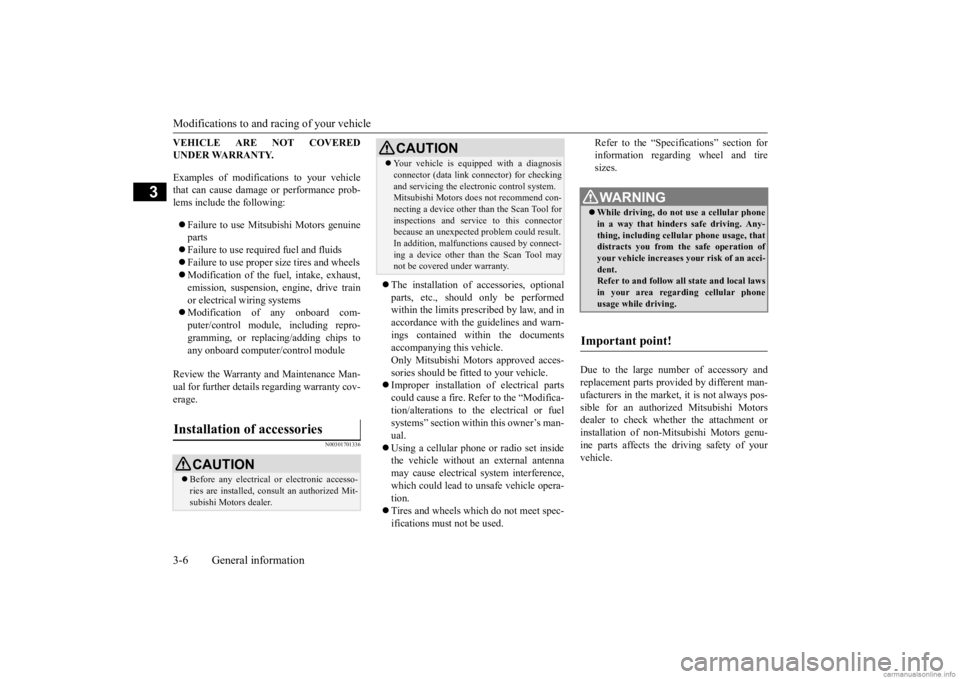
Modifications to and racing of your vehicle 3-6 General information
3
VEHICLE ARE NOT COVERED UNDER WARRANTY. Examples of modifica
tions to your vehicle
that can cause damage or performance prob- lems include the following: Failure to use
Mitsubishi Motors genuine
parts Failure to use required fuel and fluids Failure to use proper
size tires and wheels
Modification of the fuel, intake, exhaust, emission, suspension, engine, drive train or electrical wiring systems Modification of any onboard com- puter/control module, including repro- gramming, or replacing/adding chips toany onboard computer/control module
Review the Warranty and Maintenance Man- ual for further details
regarding warranty cov-
erage.
N00301701336
The installation of ac
cessories, optional
parts, etc., shoul
d only be performed
within the limits prescribed by law, and inaccordance with the
guidelines and warn-
ings contained within the documents accompanying this vehicle.Only Mitsubishi Motors approved acces- sories should be fitted to your vehicle. Improper installation of electrical parts could cause a fire. Re
fer to the “Modifica-
tion/alterations to the electrical or fuel systems” section with
in this owner’s man-
ual. Using a cellular phone or radio set inside the vehicle without an
external antenna
may cause electrical system interference, which could lead to unsafe vehicle opera- tion. Tires and wheels whic
h do not meet spec-
ifications must not be used.
Refer to the “Specifi
cations” section for
information regarding wheel and tiresizes.
Due to the large number of accessory and replacement parts provided by different man- ufacturers in the market, it is not always pos- sible for an authorized Mitsubishi Motorsdealer to check whether the attachment or installation of non-Mitsubishi Motors genu- ine parts affects the driving safety of yourvehicle.
Installation of accessories
CAUTION Before any electrical or electronic accesso- ries are installed, cons
ult an authorized Mit-
subishi Motors dealer.
Your vehicle is equi
pped with a diagnosis
connector (data link c
onnector) for checking
and servicing the elec
tronic control system.
Mitsubishi Motors does not recommend con- necting a device other than the Scan Tool for inspections and servic
e to this connector
because an unexpected
problem could result.
In addition, malfuncti
ons caused by connect-
ing a device other than the Scan Tool maynot be covere
d under warranty.
CAUTION
WA R N I N GWhile driving, do not use a cellular phone in a way that hinders safe driving. Any-thing, including cellu
lar phone usage, that
distracts you from the safe operation of your vehicle increases you
r risk of an acci-
dent. Refer to and follow al
l state and local laws
in your area regarding cellular phoneusage while driving.
Important point!
BK0278200US.book 6 ページ 2019年4月10日 水曜日 午前10時59分
Page 34 of 443
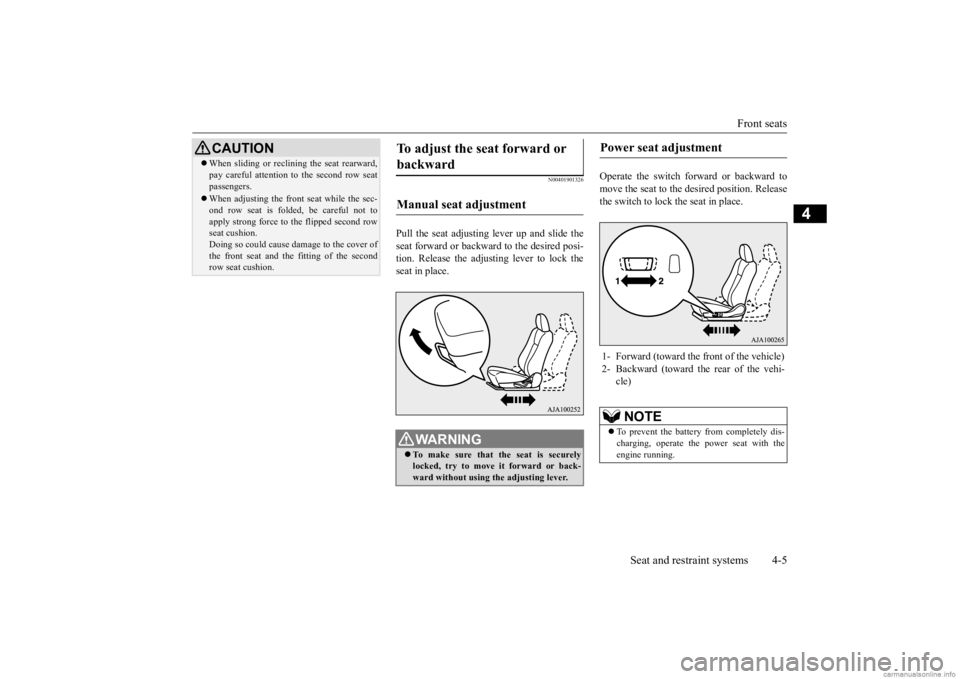
Front seats
Seat and restraint systems 4-5
4
N00401901326
Pull the seat adjusting lever up and slide the seat forward or backward to the desired posi-tion. Release the adjusting lever to lock the seat in place.
Operate the switch forward or backward to move the seat to the de
sired position. Release
the switch to lock the seat in place.
When sliding or reclin
ing the seat rearward,
pay careful attention
to the second row seat
passengers. When adjusting the front seat while the sec- ond row seat is folded, be careful not toapply strong force to the flipped second row seat cushion. Doing so could cause da
mage to the cover of
the front seat and the
fitting of the second
row seat cushion.CAUTION
To adjust the seat forward or backward Manual seat adjustment
WA R N I N G To make sure that the seat is securely locked, try to move
it forward or back-
ward without using
the adjusting lever.
Power seat adjustment 1- Forward (toward the front of the vehicle) 2- Backward (toward the rear of the vehi-
cle)NOTE
To prevent the battery from completely dis- charging, operate the
power seat with the
engine running.
BK0278200US.book 5 ページ 2019年4月10日 水曜日 午前10時59分
Page 35 of 443
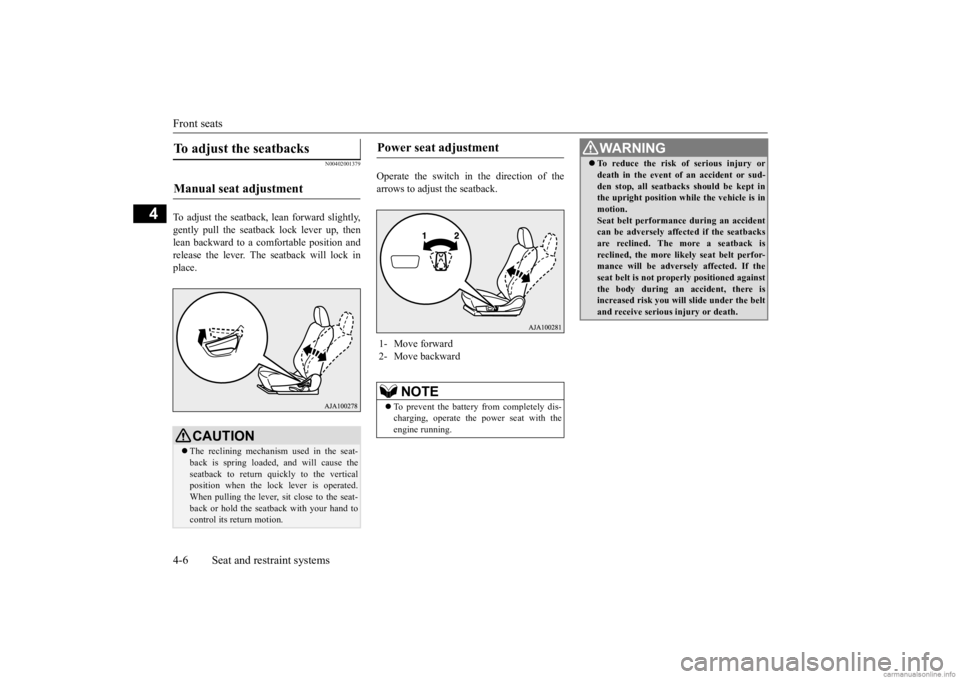
Front seats 4-6 Seat and restraint systems
4
N00402001379
To adjust the seatback, lean forward slightly, gently pull the seatback lock lever up, then lean backward to a comfortable position andrelease the lever. The seatback will lock in place.
Operate the switch in the direction of the arrows to adjust the seatback.
To adjust the seatbacks Manual seat adjustment
CAUTION The reclining mechanism used in the seat- back is spring loaded, and will cause theseatback to return quickly to the vertical position when the lock lever is operated. When pulling the lever, sit close to the seat-back or hold the seatback with your hand to control its return motion.
Power seat adjustment 1- Move forward 2- Move backward
NOTE
To prevent the battery from completely dis- charging, operate the
power seat with the
engine running.
WA R N I N G To reduce the risk of serious injury or death in the event of
an accident or sud-
den stop, all seatbacks should be kept inthe upright position while the vehicle is in motion. Seat belt performance during an accidentcan be adversely affect
ed if the seatbacks
are reclined. The more a seatback is reclined, the more likely seat belt perfor-mance will be adversely affected. If the seat belt is not proper
ly positioned against
the body during an accident, there isincreased risk you will slide under the belt and receive serious
injury or death.
BK0278200US.book 6 ページ 2019年4月10日 水曜日 午前10時59分
Page 36 of 443
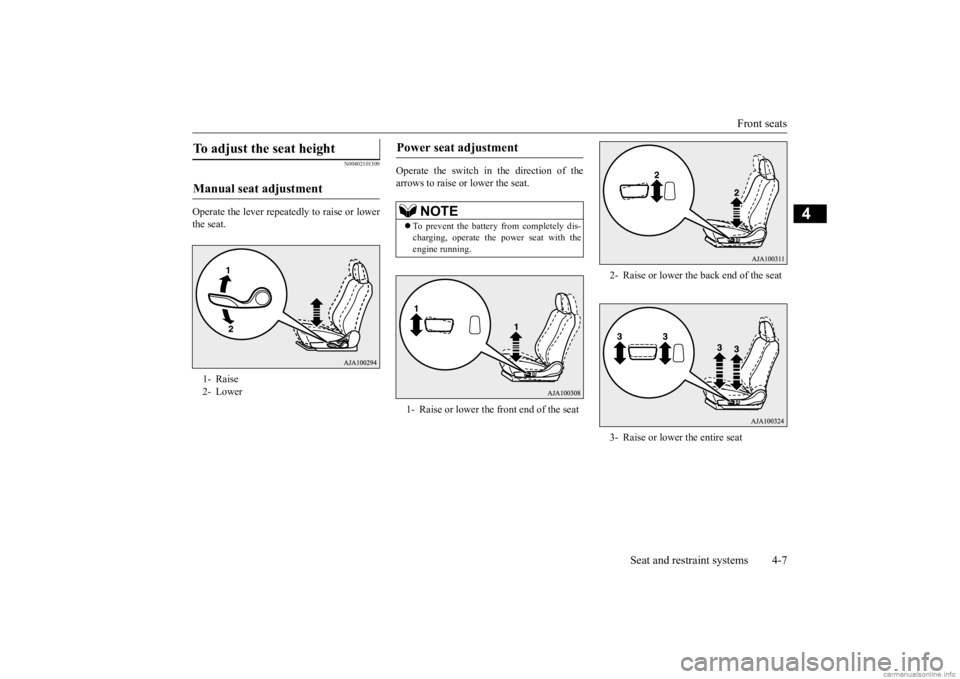
Front seats
Seat and restraint systems 4-7
4
N00402101309
Operate the lever repeatedly to raise or lower the seat.
Operate the switch in the direction of the arrows to raise or lower the seat.
To adjust the seat height Manual seat adjustment 1- Raise2- Lower
Power seat adjustment
NOTE
To prevent the battery
from completely dis-
charging, operate the power seat with theengine running.1- Raise or lower the
front end of the seat
2- Raise or lower the back end of the seat 3- Raise or lower the entire seat
BK0278200US.book 7 ページ 2019年4月10日 水曜日 午前10時59分
Page 82 of 443
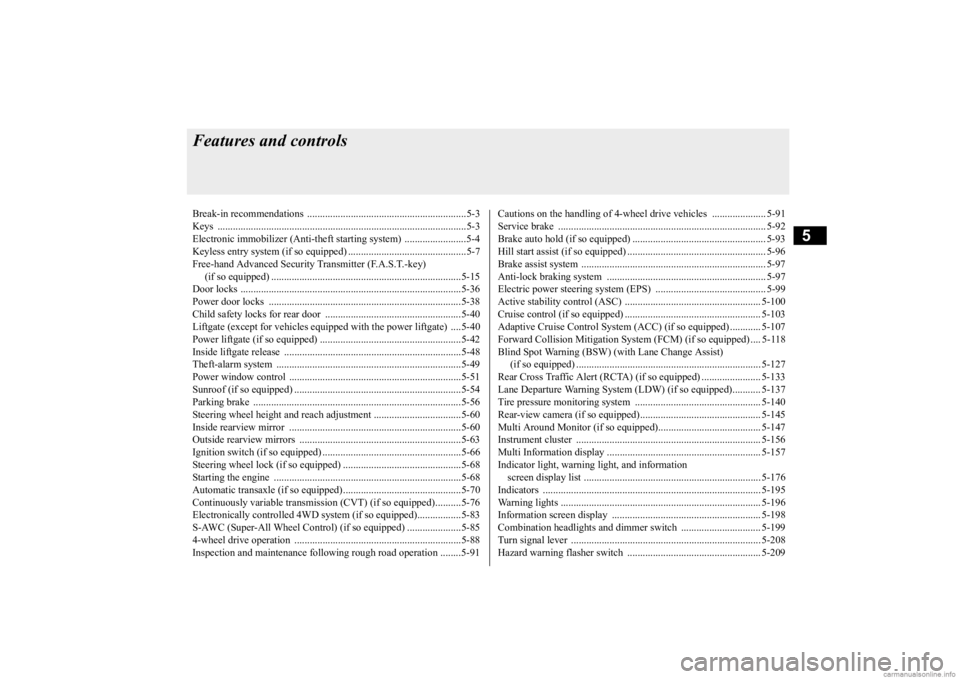
5
Features and controlsBreak-in recommendations ..............................................................5-3 Keys .................................................................................................5-3 Electronic immobilizer (Anti-theft starting system) ........................5-4Keyless entry system (if so equipped) ..............................................5-7 Free-hand Advanced Security
Transmitter (F.A.S.T.-key)
(if so equipped) ..........................................................................5-15Door locks ......................................................................................5-36 Power door locks ......
...........
...........
...........
...........
...........
.........
.....5-38
Child safety locks for rear door ..........
...........
.........
.........
.........
.....5-40
Liftgate (except for vehi
cles equipped with the
power liftgate) ....5-40
Power liftgate (if so equipped) .......................................................5-42 Inside liftgate release .....................................................................5-48Theft-alarm system ........................................................................5-49 Power window control ...................................................................5-51 Sunroof (if so equipped) .................................................................5-54Parking brake .................................................................................5-56 Steering wheel height and reach adjustment ..................................5-60 Inside rearview mirror ...................................................................5-60Outside rearview mirrors ...............................................................5-63 Ignition switch (if so equipped) ......................................................5-66 Steering wheel lock (if so equipped) ..............................................5-68Starting the engine .........................................................................5-68 Automatic transaxle (if so equipped)..............................................5-70 Continuously variable transmission
(CVT) (if so equipped)..........5-76
Electronically controlled
4WD system (if so equipped).................5-83
S-AWC (Super-All Wheel Control) (if
so equipped) .....................5-85
4-wheel drive operation .................................................................5-88Inspection and maintenance followi
ng rough road operation ........5-91
Cautions on the handling of 4-wheel dr
ive vehicles ..................... 5-91
Service brake ................................................................................. 5-92 Brake auto hold (if so equipped) .................................................... 5-93Hill start assist (if so equipped) ...................................................... 5-96 Brake assist system ........................................................................ 5-97 Anti-lock braking system .............................................................. 5-97Electric power steering system (EPS) ........................................... 5-99 Active stability control (ASC) ..................................................... 5-100 Cruise control (if so equipped) ..................................................... 5-103Adaptive Cruise Control System (ACC)
(if so equipped) ............ 5-107
Forward Collision Mitigation System
(FCM) (if so equipped) .... 5-118
Blind Spot Warning (BSW) (w
ith Lane Change Assist)
(if so equipped) ........................................................................ 5-127 Rear Cross Traffic Alert (RCTA) (if so equipped) ....................... 5-133 Lane Departure Warning System (LDW
) (if so equipped)........... 5-137
Tire pressure monitoring system ................................................. 5-140 Rear-view camera (if so equipped)............................................... 5-145 Multi Around Monitor (if so
equipped)..................
...........
........... 5-147
Instrument cluster ........................................................................ 5-156 Multi Information display ............................................................ 5-157 Indicator light, warning light, and information screen display list ..................................................................... 5-176 Indicators ..................................................................................... 5-195 Warning lights .............................................................................. 5-196Information screen display .......................................................... 5-198 Combination headlights and dimmer switch ............................... 5-199 Turn signal lever .......................................................................... 5-208Hazard warning flasher switch .................................................... 5-209
BK0278200US.book 1 ページ 2019年4月10日 水曜日 午前10時59分
Page 84 of 443
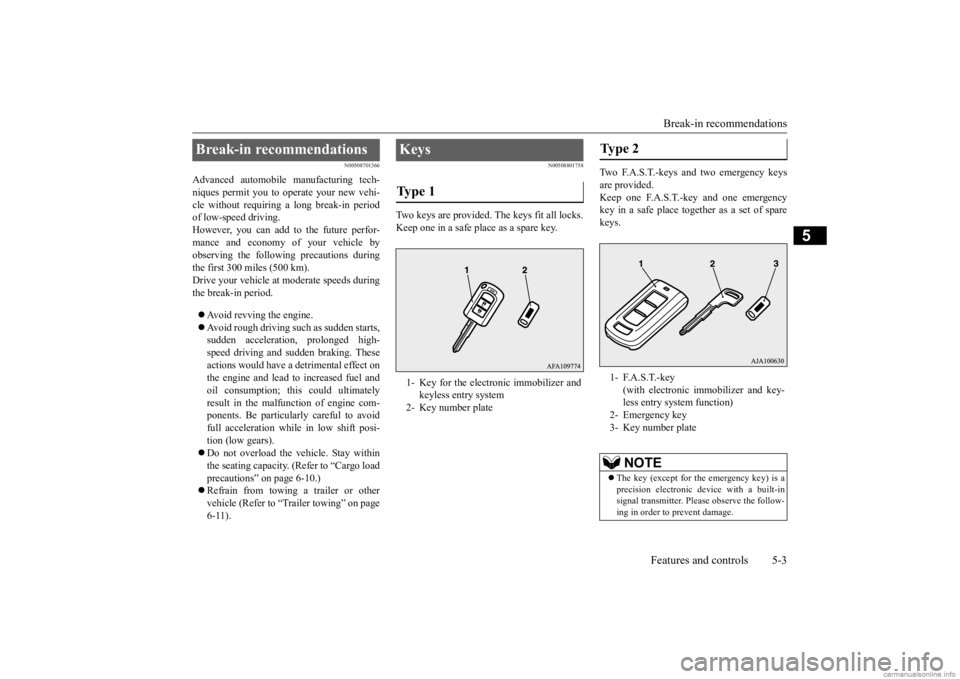
Break-in recommendations
Features and controls 5-3
5
N00508701366
Advanced automobile
manufacturing tech-
niques permit you to operate your new vehi- cle without requiring a long break-in periodof low-speed driving. However, you can add to the future perfor- mance and economy of your vehicle byobserving the following precautions during the first 300 miles (500 km). Drive your vehicle at m
oderate speeds during
the break-in period. Avoid revving the engine. Avoid rough driving such as sudden starts, sudden accelerati
on, prolonged high-
speed driving and sudden braking. These actions would have a detrimental effect onthe engine and lead to increased fuel and oil consumption; th
is could ultimately
result in the malfunction of engine com-ponents. Be particularly careful to avoid full acceleration while in low shift posi- tion (low gears). Do not overload the vehicle. Stay within the seating capacity. (Refer to “Cargo load precautions” on page 6-10.) Refrain from towing a trailer or other vehicle (Refer to “T
railer towing” on page
6-11).
N00508801758
Two keys are provided. The keys fit all locks.Keep one in a safe place as a spare key.
Two F.A.S.T.-keys and two emergency keys are provided. Keep one F.A.S.T.-key and one emergency key in a safe pl
ace together as a set of spare
keys.
Break-in recommendations
Keys Ty p e 1 1- Key for the electronic immobilizer and
keyless entry system
2- Key number plate
Type 2 1- F.A.S.T.-key
(with electronic im
mobilizer and key-
less entry system function)
2- Emergency key 3- Key number plate
NOTE
The key (except for the emergency key) is a precision electr
onic device wi
th a built-in
signal transmitter. Please observe the follow- ing in order to prevent damage.
BK0278200US.book 3 ページ 2019年4月10日 水曜日 午前10時59分